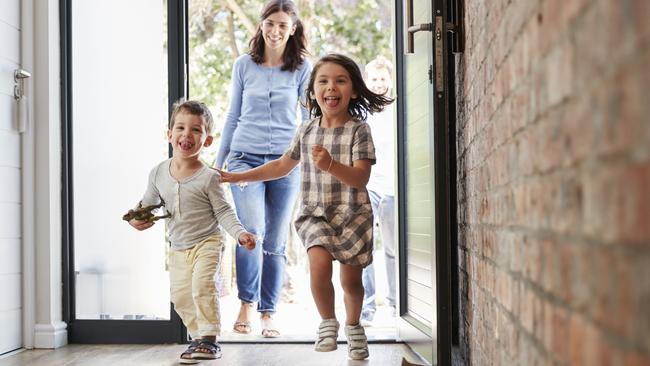Why downsizing over-55s are wary of high-rise apartments and village living after Covid
Over-55s in Melbourne’s suburbs looking to downsize would rather live in a caravan with space around them than apartment or retirement village. Here’s why.

News
Don't miss out on the headlines from News. Followed categories will be added to My News.
Harsh Covid restrictions in some ‘lifestyle’ villages during the height of the pandemic has taken the shine off that form of living for many Victorians over 55 looking to cut out a mortgage and downsize.
The prospect of adult children potentially needing to come back to the family home to live is also shaping the downsizing choices of Baby Boomers and Gen Xers.
Swinburne Professor of Housing and Social Policy and leader of the institute’s Housing Futures Research Centre for Urban Transitions, Wendy Stone said there was a misconception Melburnians looking to downsize wanted apartments, of which there was “a glut”.
But recent research showed they typically wanted multiple bedroom, detached homes in good locations — and for some this was because they believed their adult children could return to live with them in the future.
They also wanted the freedom to be able to have pets and room to indulge in their hobbies.

“They want an easier to maintain property but one that is typically still three bedroom . . . sometimes two bedroom but often it’s three,” Prof Stone said.
“They want family members and friends to be able to come and stay . . . remaining connected with family is very important to them . . . and this links into young adult and even midlife adult children needing to maybe come back and use the parental or family home.”
Research by an over-55s housing action group she was involved in showed there was a shortage of the sort of medium-sized houses “in well located areas” potential downsizers were seeking, she said.
“There’s a glut of small apartments and that’s not what people are needing or wanting, because it doesn’t serve this group very well,” Prof Stone said, adding many people in this age bracket were still working.
Even over-55s on low incomes looking to downsize and secure mortgage-free accommodation futures are not inclined to live in apartments, new research reveals.
In fact, many would rather live in a caravan than in a crowded high-rise apartment building or village style housing, because they want their freedom.
While they are seeking to reduce their financial burden and home and garden size, most don’t want to be hemmed in.
And Covid lockdowns - that saw some middle-aged people living in independent units in “lifestyle” (retirement) villages subjected to similar harsh restrictions as the nursing homes often on their grounds - had caused some over-55s to be wary.
“One of the traps for some of the more mobile, younger older people in Covid, was that they found themselves locked down in villages. They weren’t necessarily in a nursing home but they were still subject to very strict conditions . . . which I think was a real shock for some people,” Prof Stone said.
“Anecdotally . . . I am aware of at least a couple of cases where people (living in lifestyle villages) became subjected to almost like a nursing home style lockdown rather than what most of us might have experienced in Melbourne.”


A recent report by the Melbourne-based Australian Housing and Urban Research Institute (AHURI) reveals shared equity home ownership, cooperative housing arrangements and even mobile homes like caravans are all far preferable to most lower-income older Aussies than villages, or living in a mixed use apartment building, dual-key property or communal housing.
Most lower income Australians aged over-55 surveyed about downsizing said a shared equity, two bedroom home in a development of just eight units, in the outer suburbs of a capital city was their preferred way of living.
The next model most agreeable to those on limited incomes and considering downsizing was
a cooperative housing model with affordable long lease options on a two or three-bedroom home in a regional location, developed and owned by a community housing provider, and built specifically for those over-55.
A transportable home like a caravan - located in the outer suburbs of a capital city on public land - was preferred by 17.5 per cent of respondents, as long as they could secure affordable, long lease conditions and were given 12 months notice if they had to leave.
It comes as an increasing number of older Australians are retiring without outright home ownership, placing them at risk of housing insecurity, the report notes.
As such, many in the over-55s age group were open to considering different ways of achieving housing security in their older age.
“They value privacy, security of tenure, the ability to have pets and room for friends, family or carers to stay,” the joint report by Victoria’s RMIT, Curtin University, University of South Australia and Flinders University states, adding pre-pandemic research had similar findings.
“Regardless of their income or wealth, this cohort seeks stable and secure housing, privacy, two or three bedrooms in a detached or private dwelling, the ability to have a pet and access to amenities and services,” it notes.
Private indoor and outdoor spaces, private car bays and easy access to shops and public transport were considered key, with locations in outer suburbs or regional areas preferred over CBD areas or inner suburbs.
Of households that downsized, 42 per cent moved to new neighbourhoods and 37 per cent to locations they were familiar with through family or friends, or as a previous holiday destination.
Only 22 per cent move to a smaller home in the same neighbourhood as their original dwelling, with the most common reasons for their downsizing being lifestyle and financial (both 27 per cent); the garden or property requiring too much maintenance (18 per cent) and being ‘forced’ to move (15 per cent).




